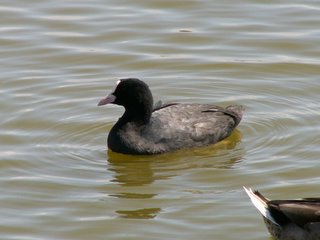.
 All-black and larger than its cousin, the moorhen, it has a distinctive white beak and 'shield' above the beak which earns it the title 'bald'. Its feet have distinctive lobed flaps of skin on the toes, which act instead of webs when swimming. It patters noisily over the water before taking off and can be very aggressive towards others..
All-black and larger than its cousin, the moorhen, it has a distinctive white beak and 'shield' above the beak which earns it the title 'bald'. Its feet have distinctive lobed flaps of skin on the toes, which act instead of webs when swimming. It patters noisily over the water before taking off and can be very aggressive towards others...
.
Where does it live?
.
.
Breeding
Likes areas of fairly shallow standing freshwater with a muddy bottom and plenty of vegetation at the sides. Mainly in lowland areas.
.
.
Wintering
Sometimes found on shallow coasts, especially when freezing weather conditions make access to freshwater difficult.
.
.
.
Where to see it?
Mainly on freshwater lakes, gravel pits, reservoirs, rivers and town park lakes when deep enough. Sometimes seen offshore, especially in winter if freshwater areas are frozen.
.
.
.
What does it eat?
Vegetation, snails and insect larvae.
.
.
.
What does it sound like?
A loud, resonant 'kut'
.
.
.
When to see it?
All year round.


Sem comentários:
Enviar um comentário